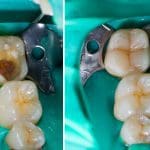Dentistry has made remarkable strides in restorative procedures, and one essential aspect is the use of bonding agents. These agents have revolutionized dental practices, enhancing the durability and aesthetics of dental restorations. Bonding agents serve as a critical link between tooth structure and restorative materials, ensuring a strong and stable connection. Understanding bonding and bonding agent materials in dentistry is fundamental to achieving successful dental procedures.
What is Bonding?
Dental bonding is the process of adhering restorative materials, such as composite resins or porcelain, to tooth structure. It involves creating a strong, durable bond between the natural tooth and the restorative material to restore function, strength, and aesthetics.
Importance of Bonding Agents
Bonding agents play a pivotal role in dental procedures by facilitating adhesion between different materials. They promote a strong bond by micromechanical and chemical interactions, ensuring stability and longevity of restorations. These agents are tailored to enhance adhesion to enamel, dentin, and various restorative materials.
Types of Bonding Agents
- Etch-and-Rinse Bonding Agents
- Self-Etch Bonding Agents
- Universal Bonding Agents
- Selective Etching
Etch-and-Rinse Bonding Agents
This type of bonding agent involves a multi-step process. It begins with the application of an etchant (usually phosphoric acid) to the tooth surface, creating a microscopically rough surface to improve adhesion. Subsequently, the bonding agent, comprising resin monomers, is applied to the etched surface before the application of restorative material.
Self-Etch Bonding Agents
Self-etch systems combine the etching and priming steps into a single application. These agents contain acidic monomers that simultaneously etch and prime the tooth surface, simplifying the bonding procedure. They are available in various formulations, including mild, moderate, and strong self-etch adhesives, providing options for different clinical scenarios.
Universal Bonding Agents
Universal bonding agents offer versatility, as they can be used in both etch-and-rinse and self-etch techniques. They provide convenience and adaptability in various clinical situations, allowing dentists to choose the preferred bonding strategy without changing the adhesive material.
Selective Etching
Selective etching involves the targeted application of an etchant to specific areas of the tooth structure. This technique aims to optimize adhesion by selectively treating enamel or dentin, depending on the clinical requirements.
Factors Affecting Bonding Effectiveness
- Moisture Control
- Cavity Preparation and Condition
- Material Compatibility
Moisture Control
Effective bonding necessitates proper isolation and control of moisture during the bonding procedure. Moisture contamination can compromise bond strength and durability, leading to restoration failure.
Cavity Preparation and Condition
The quality of cavity preparation significantly influences bonding effectiveness. Proper cleaning, shaping, and conditioning of the tooth surface are crucial for optimal adhesion.
Material Compatibility
The compatibility between the bonding agent and restorative materials is essential for long-term success. Using compatible materials ensures a stable interface and reduces the risk of debonding or degradation.
Clinical Applications of Bonding Agents

- Composite Restorations
- Bonding in Prosthodontics
- Orthodontic Applications
Composite Restorations
Bonding agents are extensively used in composite resin restorations, providing excellent adhesion to enamel and dentin. They contribute to the success of direct composite fillings, veneers, and other aesthetic dental treatments.
Bonding in Prosthodontics
In prosthodontics, bonding agents are crucial for cementing indirect restorations like crowns, bridges, and inlays/onlays. They create a reliable bond between the prosthetic restoration and the prepared tooth structure.
Orthodontic Applications
Bonding agents are also integral in orthodontics for attaching brackets or bands to teeth. They facilitate the bonding of orthodontic appliances, enabling controlled tooth movement and alignment.
Challenges and Advancements
- Sensitivity to Technique Sensitivity
- Nanotechnology in Bonding
Sensitivity to Technique Sensitivity
Achieving consistent and reliable bonding can be challenging due to technique sensitivity and variations in clinical conditions. Advancements in bonding technology aim to minimize technique sensitivity and enhance predictability.
Nanotechnology in Bonding
The integration of nanotechnology has led to the development of nanofilled and nanohybrid bonding agents. These materials offer improved mechanical properties, reduced shrinkage, and enhanced bond strength, contributing to more reliable restorations.
Enhancements in Bonding Agent Technology
- Bonding Agent Simplification
- Universal Adhesives
- Hydrophobicity and Hydrophilicity
Bonding Agent Simplification
Recent developments focus on simplifying bonding procedures without compromising bond strength. One-step or simplified multi-step systems aim to streamline the application process, reducing chair time and potential errors while maintaining reliable adhesion.
Universal Adhesives
Universal adhesives represent a significant advancement, offering compatibility with various substrates and restorative materials. These versatile agents simplify inventory management in dental practices by catering to multiple bonding protocols, including etch-and-rinse, self-etch, and selective etching techniques.
Hydrophobicity and Hydrophilicity
Achieving a balance between hydrophobic and hydrophilic properties in bonding agents is crucial. Hydrophobic agents repel moisture, aiding in reliable bonding, while hydrophilic agents enhance penetration into moist dentin, improving bond strength in challenging clinical conditions.
Overcoming Bonding Challenges
- Adhesive Interface Stability
- Bonding to Different Substrates
Adhesive Interface Stability
Continuous research aims to improve the long-term stability of the adhesive interface. Strategies involve developing agents that resist degradation from oral fluids, reducing microleakage, and preventing secondary caries.
Bonding to Different Substrates
Enhancing bonding to challenging substrates, such as sclerotic dentin or specific restorative materials, remains a focus. Novel bonding agents with modified formulations and surface treatments aim to optimize adhesion in diverse clinical scenarios.
Conclusion
Bonding agents are indispensable in modern dentistry, playing a vital role in various restorative and cosmetic procedures. Advancements in bonding technology continue to refine these agents, aiming for better adhesion, durability, and clinical outcomes. Understanding the different types of bonding agents, their applications, and factors influencing bonding effectiveness is crucial for dental professionals to achieve successful and long-lasting restorations, ensuring optimal oral health and patient satisfaction.





